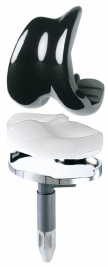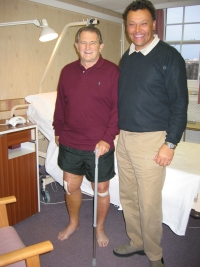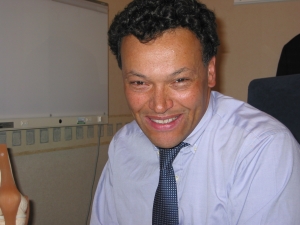


Bristol Knee Clinic

| + home | |
| + news | |
| + research | |
| + patient information | |
| + the clinic | |
| + the surgeon | |
| + sport physiotherapy | |
| + sports advice | |
| + medico legal | |
| + products | |
| + resources | |
| + contact | |
| + maps | |
| + directions | |
| + site map |
The Bristol Knee Clinic |
News Topic : Full Version
Recent Advances in Knee and Hip Replacement - May 2007
Author: Webmaster Date: 10/19/2007
"Mr Johnson publishes article on the latest technology and surgical implants including the Oxinium knee replacement and minimally invasive surgery"

Joint replacement has changed rapidly over the last few years. The results are continually improving. However the latest technology, surgical techniques and implants are not universally available or well understood by most patients. The Bristol Orthopaedic Clinic and David Johnson, a Consultant Orthopaedic Surgeon, who specialises in joint replacement explains.
New Implants
Recent advances have resulted in a variety of new and improved materials, bearing surfaces and new types of joint implants. Perhaps the best known is the Resurfacing Hip Replacement. This was developed in Birmingham and has rapidly become an accepted and important part of the treatment of hip arthritis in young or active people. Indeed the results, functional abilities and return to sports enjoyed by patients has proven to be very encouraging.


New Materials
The development of new materials has lead to the development of ceramic joint replacements. These ceramic joints have a much reduced rate of wear and consequently the joints are expected to last much longer than with conventional joint replacements. These materials have included Oxinium Knee Replacements which are expected to last up to 85% longer than conventional joint replacements. Additionally the introduction of new improved and strengthened polyethylene will reduce long term wear even further. These ceramic joints are therefore suitable for younger more active or heavier patients and those expecting to return to an active lifestyle and sports.
Minimally Invasive Surgery
Minimal Invasive Surgery or MIS is the operative technique of using a mini-incision for the insertion of a joint replacement. This technique uses less cutting of muscles and tendons and therefore results in less pain and swelling after surgery. This allows patients to recover mobilise and leave hospital much more rapidly. The technique was first developed for Hip replacement but David Johnson has been instrumental in introducing the technique in the UK and indeed throughout Europe. David has undertaken lectures and demonstrations on the technique throughout Europe including Germany, Spain, Holland and Poland.
Hospital Stay
Using the new MIS surgical techniques, hospital stay for joint replacement is now much shorter than it once was. Patients can often expect to be at home after only 3 or 4 days. Patients at this time can now expect to be only taking paracetamol tablets for pain relief and be able to look after themselves, walk outdoors and climb stairs. Often one or two sticks are used but often only for a week or two. Patients can often return to work and driving after as little as 4 weeks following surgery.
Hospital cleanliness and infection, particularly MRSA infection is a current area of concern in many NHS hospitals. Fortunately in Private Hospitals MRSA is much less of a problem. This results from a variety of factors including the cleanliness of the wards. The introduction of antibiotics to prevent infection and anticoagulants to prevent thrombosis has been shown to be effective in reducing the problems to a minimum. David has been involved in medical research to minimise the risks of infection following joint replacement.

Sports After Joint Replacement
The results of joint replacement continue to improve, recovery is much quicker and patients increasingly return to their normal lifestyle. Patients now can expect to rapidly return to activities, pastimes and sport. It should now be expected that following joint replacements most patients would be able to return to start pool exercises and swimming after 2-4 weeks, driving, recreational walking and gym exercises after 4-6 weeks, golf after 6 weeks. Certain activities associated with impact, twisting or jarring such as jogging and squash should be avoided. Mr. Wright a patient from Newcastle who underwent a Ceramic Oxinium Knee Replacement shot a gross score of 74 whilst playing golf at a championship course in South Africa only 6 months later. David said “this is a better score than I can achieve at golf with my original knees. It is wonderful and reassuring that patients can now get back to fully enjoying life after joint replacement”.
How Long Do Joint Replacements Last
In reasonably fit people a well inserted joint replacement should be expected to last at least 15-20 years and when a ceramic joint is used the potential is for the joint to last much longer than that. Indeed joint replacement is generally so successful that most patients can expect to return to their normal lifestyle, sports and recreation without restriction. Indeed one patient recently wrote to David Johnson saying: “I have absolutely no problems at all. The result is brilliant, has transformed my quality of life. I have about 120° flexion and can walk miles and cycle happily with it.”

David Johnson, Consultant Orthopaedic Surgeon, has a special interest and international reputation for treating arthritic joints and sports injuries. He has developed specialised MIS techniques and uses the latest ceramic joints for knee and hip replacement. David has worked at the Bristol Orthopaedic Clinic for 15 years, has written a text book on knee surgery and is regularly invited to lecture and demonstrate surgical techniques around the world. In March 2007 he was lecturing in Germany and in April 2007 has been invited to spend a week in Saudi Arabia lecturing and demonstrating the latest surgical techniques in joint replacement.
© The Bristol Orthopaedics and Sports Injuries Clinic 2003. The Bristol Knee Clinic is a trading name of the Bristol Orthopaedic Clinic Ltd. privacy / copyright | contact | Powered By Create Medical



